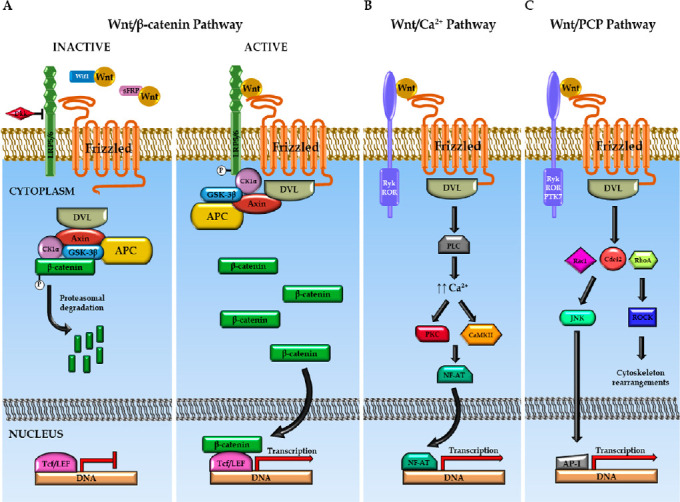Figure 1.

Schematic overview of Wnt signaling pathways.
(A) In the canonical Wnt pathway, the absence of Wnt signal leads to proteasomal degradation of β‐catenin mediated by a multiprotein destruction complex including GSK-3β and CK1α kinases, responsible of β‐catenin phosphorylation. The binding of the Wnt ligand to its Fz receptor and to LRP5/6 co-receptor leads to the recruitment of DVL together with the destruction complex to the cell membrane. As a consequence, GSK-3β and CK1α mediated phosphorylation of β-catenin is inhibited, and the stabilized β-catenin is translocated to the nucleus where it serves as co-activator for Tcf/LEF transcription factors. (B) In the non-canonical Wnt/Ca2+ signaling pathway, the binding of Wnt ligands to their specific receptors activates PLC, leading to intracellular Ca2+ release and the subsequent activation of PKC and CaMKII which, in turn, regulate NF-AT transcription factor and gene expression. (C) In the non-canonical Wnt/PCP signaling pathway, the interaction of Wnt ligand with the receptor triggers a signaling cascade that involves small Rho-family GTPases and downstream effectors such as JNK and ROCK, which in turn modulate cytoskeleton organization and gene expression (modified from Gonzalez-Fernandez et al., 2016a). CaMKII: Calcium-calmodulin-dependent protein kinase II; CK1α: β‐catenin phosphorylation casein kinase 1; DVL: Dishevelled; Fz: Frizzled; GSK-3β: glycogen synthase kinase 3β; NF-AT: nuclear transcription factor of activated T-cells; PKC: protein kinase C; Tcf: T cell factor family.
